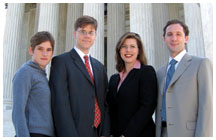|
Web Exclusives: Alumni Spotlight July 19, 2006:
Behind the scenes at high court
The court’s eight associate justices typically have four clerks each, for a year at a time. Clerks tend to have worked for other federal judges. Last year, Daniel Kearney ’96 was wrapping up with Judge John Roberts on the U.S. Court of Appeals when President Bush nominated Roberts to lead the Supreme Court. Kearney became one of Roberts’ clerks. Jeffrey Pojanowski ’00 also had clerked for Roberts on the lower court but joined Justice Anthony Kennedy’s chambers last year. “It’s more luck than anything, being in the right place at the right time, with the right people,” said Benjamin Horwich ’99, who started the term with Justice Sandra Day O’Connor and moved to Alito’s chambers when he replaced her. As a privilege of retirement, O’Connor kept one of her clerks, Amy Kapczynski ’96, who assists with speeches and other writing and research. The current 2005 term technically runs from October 2005 to October
2006, but clerks depart at various times in July. Although clerks and justices usually work together for only a term, they often remain close, said Hannah Clayson Smith ’95. When Alito, her former boss on the Court of Appeals, was nominated to the high court, he asked for Smith’s help in preparing for his confirmation hearings and then invited her to join his chambers. Now that their clerkships are almost over, the Princetonian clerks
are weighing their options. Law firms clamor for departing Supreme
Court clerks and dangle $200,000 bonuses for signing on —
far more than the $63,335 they earned at By Massie Ritsch ’98 Massie Ritsch ’98 is communications director for the Center for Responsive Politics in Washington, D.C.
|
||

